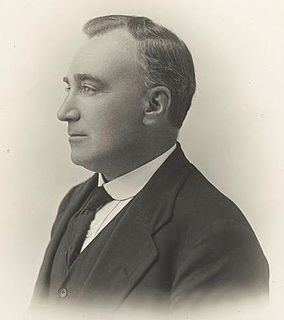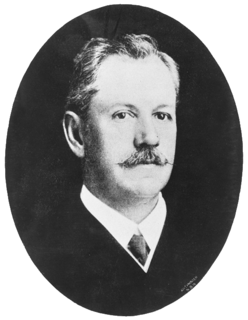Related Research Articles

James Squire Farnell was an Australian politician and Premier of New South Wales. Farnell was a hard-working legislator who gave much study to the land question and also tried hard for some years to pass a bill for the regulation of contagious diseases.

Major General Herbert William Lloyd, was an Australian Army officer who served in the First and Second World Wars.
Cumberland was an electoral district of the Legislative Assembly in the Australian state of New South Wales from 1856 to 1859, in the rural part of Cumberland County, which includes Sydney. It included all of the county south of Parramatta Road and the Great Western Highway, except for the urban electorates of Sydney (City), Sydney Hamlets, Parramatta and Cumberland Boroughs, which included Liverpool and Campbelltown. It elected two members simultaneously, with voters casting two votes and the first two candidates being elected.
Yaralla was an electoral district of the Legislative Assembly in the Australian state of New South Wales. It was created in 1968, named after Yaralla Estate and largely replaced Concord, extending west to the districts of Parramatta and Granville. It also extended to the north of the Parramatta River, absorbing parts of Eastwood, Parramatta and Ryde It was abolished in 1981 with the area south of the river being absorbed by Electoral district of Burwood and the area north of the river by the re-created district of Ryde. The first member was Lerryn Mutton (Liberal) who had previously unsuccessfully contested Concord. The sitting member Garry McIlwaine (Labor) successfully contested Ryde.
Annandale was an electoral district of the Legislative Assembly in the Australian state of New South Wales, created in 1894, with the abolition of multi-member constituencies, from part of Balmain, and named after and including the Sydney suburb of Annandale. With the introduction of proportional representation, it was absorbed into the multi-member electorate of Balmain. It was recreated in 1927, but was abolished in 1950, and partly replaced by Newtown-Annandale.
Alexandria was an electoral district of the Legislative Assembly in the Australian state of New South Wales, created in 1904, partly replacing Waterloo, and named after and including the Sydney suburb of Alexandria. With the introduction of proportional representation, it was absorbed into the multi-member electorate of Botany. It was recreated in 1927, but was abolished in 1930.
Concord was an electoral district of the Legislative Assembly of the Australian state of New South Wales, created in 1930, and named after and including the Sydney suburb of Concord. It was abolished in 1968.

Albert Edward Rowe was an Australian politician. He won the seat of Parramatta for the Australian Labor Party in 1929, but was defeated by Frederick Stewart in 1931.
Albert Bruntnell was an Australian politician. He was a member of the New South Wales Legislative Assembly from 1906 until his death and held a number of ministerial positions in the Government of New South Wales. He was a conservative and at various times he represented the Liberal and Reform and the Nationalist parties.
Members of the New South Wales Legislative Assembly who served in the seventh parliament of New South Wales held their seats from 1872 to 1874.</ref> The 182 election was held between 13 February and 28 March 1872 with parliament first meeting on 30 April 1872. There were 72 members elected for 52 single member electorates, 6 two member electorates and 2 four member electorates. The maximum term of this parliament was 3 years. However the assembly was dissolved after 32 months. Henry Parkes was the premier for the duration of the parliament. The Speaker was William Arnold.
Members of the New South Wales Legislative Assembly who served in the eighth parliament of New South Wales held their seats from 1874 to 1877.</ref> The 1874–75 election was held between 8 December 1874 and 12 January 1875 with parliament first meeting on 27 January 1875. There were 72 members elected for 52 single member electorates, 6 two member electorates and 2 four member electorates. During this parliament the number of graduates of Sydney University exceeded 100 and the seat of University of Sydney was created. The maximum term of this parliament was 3 years and the assembly was dissolved after 34 months. Premiers during this parliament were Sir John Robertson 9 February 1875 till 22 March 1877 and from 17 August 1877 and Sir Henry Parkes 22 March 1877 till 17 August 1877. The Speaker was William Arnold until his death on 1 March 1875 and then George Allen.
Members of the New South Wales Legislative Assembly who served in the 28th parliament of New South Wales held their seats from 1927 to 1930. They were elected at the 1927 state election, and at by-elections. The Speaker was Sir Daniel Levy.</ref>
Members of the New South Wales Legislative Assembly who served in the 23rd parliament of New South Wales held their seats from 1913 to 1917. They were elected at the 1913 state election on 6 December 1913.</ref> The Speaker was Richard Meagher.
Annandale, an electoral district of the Legislative Assembly in the Australian state of New South Wales, had two incarnations, the first from 1894 to 1920, the second from 1927 to 1950.
Parramatta, an electoral district of the Legislative Assembly in the Australian state of New South Wales, has continuously existed since the establishment of the Legislative Assembly in 1855.

The 1907 New South Wales state election was held on 10 September 1907 for all of the 90 seats in the 21st New South Wales Legislative Assembly and it was conducted in single-member constituencies with a first past the post voting system. Both adult males and females were entitled to vote, but not Indigenous people. The 20th parliament of New South Wales was dissolved on 19 August 1907 by the Governor, Sir Harry Rawson, on the advice of the Premier, Sir Joseph Carruthers.
The 1907 New South Wales state election involved 90 electoral districts returning one member each and was held on 10 September 1907.
Hugh Taylor was an Australian politician.
The 1858 New South Wales colonial election was to return 54 members of Legislative Assembly composed of 34 electoral districts with 18 returning 1 member, 13 returning 2 members, two returning 3 members and one returning 4 members, all with a first past the post system. In multi-member districts, because each voter could cast more than one vote, it is not possible to total the votes to show the number of voters and voter turnout in these districts is estimated. 17 members from 14 districts were returned unopposed. The electoral districts and boundaries were established under the Electoral Act 1851 (NSW) for the former Legislative Council.
A by-election was held for the New South Wales Legislative Assembly electorate of Ashfield on 5 October 1929 because of the resignation of Milton Jarvie (Nationalist).
References
- ↑ "Mr Albert Bruntnell(1866-1929)". Former Members of the Parliament of New South Wales . Retrieved 11 May 2019.
- 1 2 Green, Antony. "1929 Parramatta by-election". New South Wales Election Results 1856-2007. Parliament of New South Wales . Retrieved 21 September 2019.